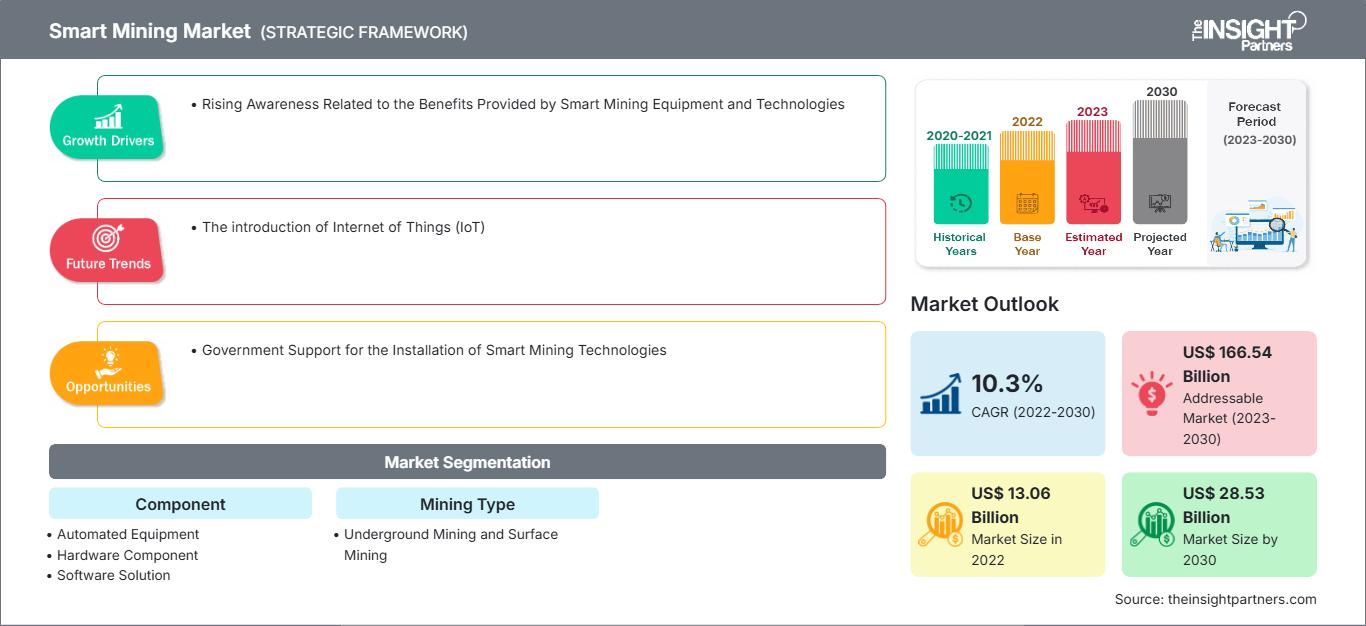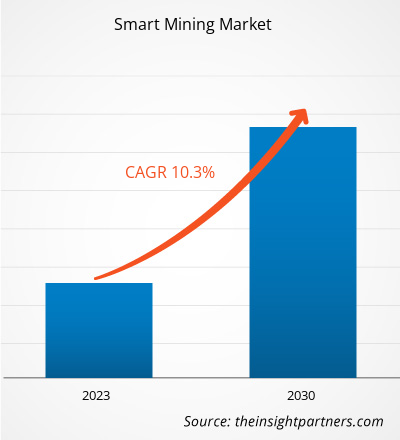2022 年智能采矿市场规模为 130.6 亿美元,预计到 2030 年将达到 285.3 亿美元。据估计,2022 年至 2030 年期间智能采矿市场的复合年增长率为 10.3%。物联网 (IoT) 的引入可能仍将是市场的主要趋势。
智能采矿市场分析
人们对智能采矿设备和技术带来的好处的认识不断提高,以及对保障员工安全日益增长的需求,正在推动市场的发展。由于企业对智能采矿组件的需求不断增长以提高数据安全性,预计预测期内市场将会增长。此外,政府对安装智能采矿技术的支持以及自动化采矿设备的日益普及,为市场创造了丰厚的利润。
智能采矿市场概览
智能采矿是指在采矿业中使用链接技术。这些技术包括摄像头、传感器和无人机,它们通过互联网相互通信并与周围环境进行通信。设备网络有助于实现流程自动化、简化操作、收集数据并连接采矿流程的各个环节。智能采矿技术有助于矿山提高效率、节省成本、保障工人安全并减少污染。
自定义此报告以满足您的要求
您将免费获得任何报告的定制,包括本报告的部分内容,或国家级分析、Excel 数据包,以及为初创企业和大学提供超值优惠和折扣
智能采矿市场: 战略洞察

-
获取本报告的主要市场趋势。这个免费样本将包括数据分析,从市场趋势到估计和预测。
世界正在探索智能采矿技术,以改善其采矿业。数字化和工业自动化的增长有助于矿业公司提高运营效率。这些好处有助于该国扩大采矿活动。例如,2023 年,意大利政府宣布恢复关键原材料的采矿作业。该矿山含有多种材料,例如锂、钴、镍、铜、锌、铍和钨。政府还估计,该国至少拥有地下 34 种元素中的 15 种。恢复采矿活动需要智能设备和技术来简化采矿作业。这些智能采矿技术可帮助工人提高生产效率,最大限度地减少对环境的影响。
政府支持智能采矿技术的应用
政府还在1000多个煤炭设施中安装了智能采矿技术,将年产能提高到6.2亿吨以上。此外,中国正在通过在陕西省煤矿带部署红柳林“智能矿井”来实现煤炭设施的现代化,力争到2030年消除温室气体排放峰值。智能采矿技术的可持续性优势推动了中国市场的发展。因此,在预测期内,越来越多的宣传活动、会议、展览等可能会为智能采矿市场创造增长机会。
智能采矿市场报告细分分析
有助于得出智能采矿市场分析的关键细分是组件和采矿类型。
- 根据组件,智能采矿市场分为自动化设备、硬件组件、软件解决方案和服务。自动化设备细分市场包括装载运输自卸车、机器人卡车、钻机和破碎机、挖掘机等。硬件组件细分市场包括 RFID 标签、传感器、智能系统等。软件解决方案细分市场包括物流软件和解决方案、数据和运营管理软件和解决方案、安全和安保系统、连接解决方案、分析解决方案、远程管理解决方案以及资产管理解决方案。2022 年,自动化设备细分市场占据了更大的市场份额。
- 根据采矿类型,市场分为地下采矿和露天采矿。2022 年,地下采矿细分市场占据了更大的市场份额。
按地区划分的智能采矿市场份额分析
智能采矿市场报告的地理范围主要分为五个地区:北美、亚太地区、欧洲、中东和非洲以及南美和中美洲。
由于采矿活动数量的增加,预计欧洲市场在预测期内将扩大。例如,2022年10月,Imerys Mining启动了EMILI(Imerys锂云母开采项目)项目,在法国开采锂矿。该项目将从2028年起每年生产3.4万吨氢氧化锂,这将增强法国乃至欧洲的工业主权,从而增加锂电池产量。这些项目有助于Imerys Mining整合并增强其能源转型能力,以减少与采矿活动相关的碳足迹。锂矿开采通常涉及使用自动驾驶车辆和机器人系统来提高矿场的效率和安全性。法国日益普及的智能采矿技术预计将推动市场发展。
智能采矿市场
智能挖矿市场The Insight Partners 的分析师已详尽阐述了预测期内影响智能采矿市场的区域趋势和因素。本节还讨论了北美、欧洲、亚太地区、中东和非洲以及南美和中美洲的智能采矿市场细分和地域分布。
智能采矿市场报告范围
| 报告属性 | 细节 |
|---|---|
| 市场规模 2022 | US$ 13.06 Billion |
| 市场规模 2030 | US$ 28.53 Billion |
| 全球复合年增长率 (2022 - 2030) | 10.3% |
| 历史数据 | 2020-2021 |
| 预测期 | 2023-2030 |
| 涵盖的领域 |
By 组件
|
| 覆盖地区和国家 |
北美
|
| 市场领导者和主要公司简介 |
|
智能采矿市场参与者密度:了解其对业务动态的影响
智能采矿市场正在快速增长,这得益于终端用户需求的不断增长,而这些需求的驱动因素包括消费者偏好的演变、技术进步以及对产品优势的认知度的提升。随着需求的增长,企业正在扩展其产品线,不断创新以满足消费者需求,并抓住新兴趋势,从而进一步推动市场增长。

- 获取 智能采矿市场 主要参与者概述
智能采矿市场评估通过收集一手和二手研究后的定性和定量数据进行,这些数据包括重要的公司出版物、协会数据和数据库。以下列出了智能采矿市场的一些发展:
- 这家矿业巨头已部署了 ABB Ability 运营管理系统 & (OMS 41;位于珀斯东北 740 公里的矿场。OMS 有助于 GoldField 对 Granny Smith 业务进行数字化转型,旨在提高生产力和简化数据流,以便及时做出决策。每年约有 160 万吨含金矿石从地下矿场开采出来,并在现场的加工厂进行处理。(来源:ABB 有限公司,公司网站,2023 年 9 月)
智能采矿市场报告范围和可交付成果
《智能采矿市场规模和预测(2020-2030 年)》报告对市场进行了详细的分析,涵盖以下领域:
- 智能采矿市场规模和预测,涵盖范围内所有关键细分市场的全球、区域和国家/地区
- 智能采矿市场趋势以及市场动态,例如驱动因素、限制因素和关键机遇
- 详细PEST/波特五力模型和 SWOT 分析
- 智能采矿市场分析涵盖关键市场趋势、全球和区域框架、主要参与者、法规和最新市场发展
- 行业格局和竞争分析涵盖市场集中度、热图分析、知名参与者和智能采矿市场的最新发展
- 详细的公司简介
- 历史分析(2 年)、基准年、预测(7 年)及复合年增长率
- PEST和SWOT分析
- 市场规模、价值/数量 - 全球、区域、国家
- 行业和竞争格局
- Excel 数据集
近期报告
相关报告
客户评价
购买理由
- 明智的决策
- 了解市场动态
- 竞争分析
- 客户洞察
- 市场预测
- 风险规避
- 战略规划
- 投资论证
- 识别新兴市场
- 优化营销策略
- 提升运营效率
- 顺应监管趋势






















 获取免费样品 - 智能采矿市场
获取免费样品 - 智能采矿市场